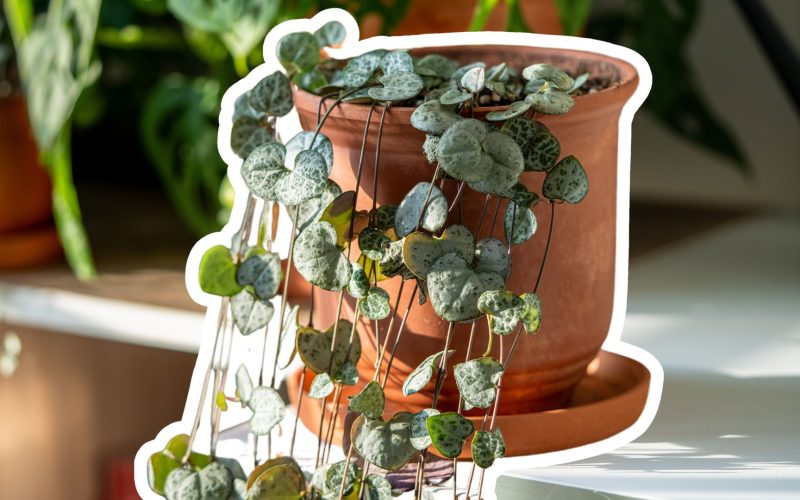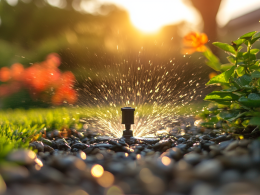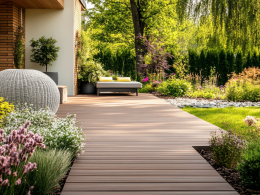With its delicate heart-shaped leaves cascading down in elegant vines, the String of Hearts plant has stolen the hearts of plant enthusiasts worldwide.
But many struggle to keep this beautiful succulent thriving, unsure of its specific care needs and how to help it reach its full potential.
Don’t worry – with the right knowledge and techniques, you can easily grow a lush, healthy String of Hearts that will be the envy of all your plant-loving friends.
This comprehensive guide will teach you everything you need to know about cultivating and caring for your String of Hearts.
We’ll cover all aspects of care, including light and temperature requirements, watering and humidity needs, soil and fertilizer recommendations, pruning and propagation techniques, common problems and how to solve them, and much more.
Whether you’re a beginner just starting or an experienced plant parent looking to refine your skills, this guide has something for everyone.
Let’s dive in and discover how to help your String of Hearts flourish!
Factors to Keep in Mind While Caring for Strings of Heart
While String of Hearts plants are generally easy to care for, there are several key factors to keep in mind to ensure your plant thrives.
By paying attention to these important aspects, you can provide optimal care and enjoy a healthy, vibrant plant.
Let’s explore the crucial elements contributing to successful String of Hearts cultivation.
1. Choosing the Right Environment
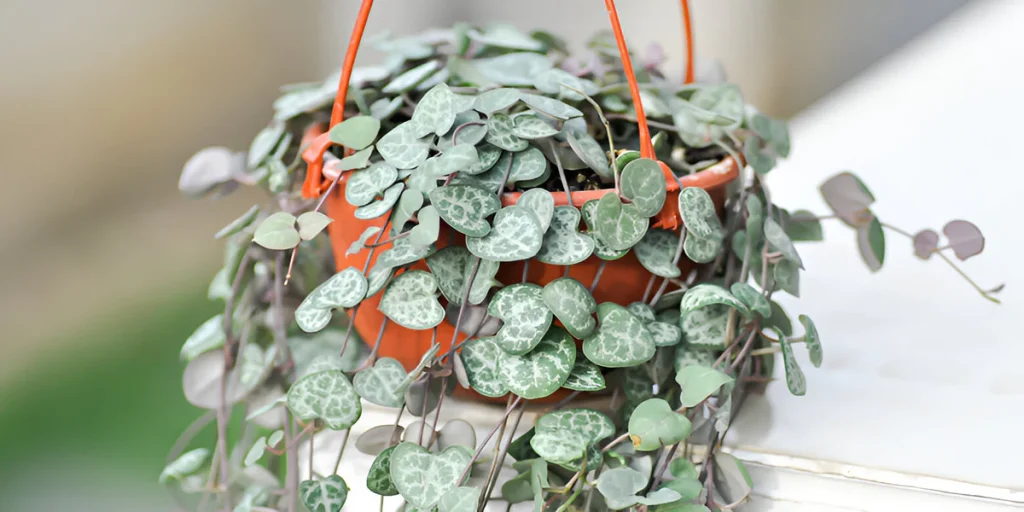
Creating the perfect environment for your String of Hearts is crucial for its growth and overall health.
Let’s explore the key factors to consider when setting up your plant’s new home.
Light Requirements
Bright, indirect light is ideal for String of Hearts plants.
These succulents thrive in well-lit areas but can be sensitive to harsh, direct sunlight.
A good rule of thumb is to place your plant near a window where it can receive plenty of ambient light throughout the day.
East or west-facing windows often provide the perfect balance of light intensity.
If you notice your plant’s leaves becoming pale or the spaces between leaves increasing, it may be a sign that it needs more light.
On the other hand, if leaves start showing signs of scorching or developing brown spots, they might receive too much direct sunlight.
In such cases, consider moving the plant slightly away from the window or using a sheer curtain to filter the light.
Suitable placements for your String of Hearts include hanging baskets near windows, on shelves that receive ample indirect light, or even in a bright room away from direct window exposure.
Remember to rotate your plant occasionally to ensure all sides receive equal light.
This will promote even growth and maintain its attractive, cascading form.
Temperature and Humidity
String of Hearts plants are adaptable to temperature and humidity, making them suitable for most indoor environments.
The optimal temperature range for these plants is between 60-85°F (15 and 29°C), which is well within the average room temperature in most homes.
During winter, be mindful of cold drafts from windows or doors, as sudden temperature drops can stress the plant.
Similarly, keep your String of Hearts away from heat sources like radiators or air conditioning vents, which can cause rapid fluctuations in temperature and humidity.
When it comes to humidity, String of Hearts plants are quite forgiving.
They can thrive in average humidity levels, typically around 40-50%.
This adaptability to drier environments makes them excellent home choices in various climates.
However, if you live in a particularly dry area or use indoor heating frequently, your plant may benefit from a slight increase in humidity.
To provide a bit of extra humidity, you can mist the leaves occasionally, place a pebble tray filled with water near the plant, or use a small humidifier in the room.
These methods can help create a more favorable environment, especially during drier seasons or in arid climates.
2. Planting and Soil
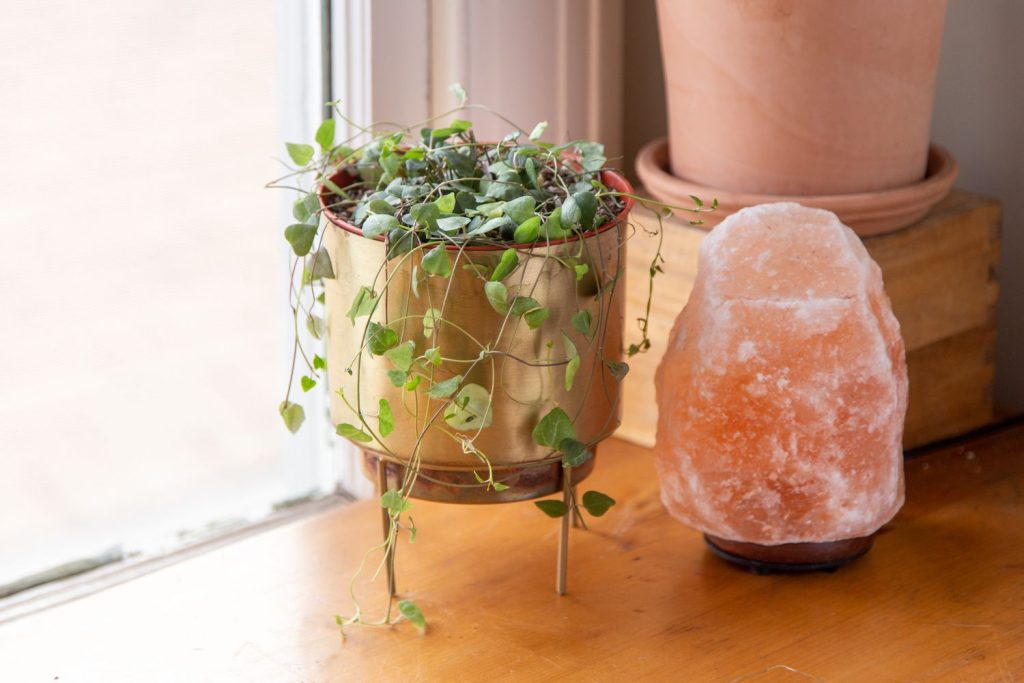
Providing the right soil and planting conditions is essential for the health and growth of your String of Hearts.
This section will guide you through selecting the ideal soil composition and the best pot for your plant.
Soil Composition
The key to a thriving String of Hearts lies in its soil composition.
These plants require a well-draining soil mix that allows excess water to flow through quickly, preventing water retention that can lead to root rot.
A good starting point is to use a commercial cactus or succulent mix formulated to provide the right balance of nutrients and drainage.
Add extra perlite or pumice to your soil mix to enhance drainage further.
A ratio of about two parts cactus soil to 1 part perlite or pumice works well.
This combination ensures that water moves freely through the soil, reducing the risk of overwatering and providing the roots with the oxygen they need.
Avoiding waterlogged soil is crucial for preventing root rot, a common issue with String of Hearts plants.
If you notice that water takes a long time to drain from the pot after watering, it’s a sign that your soil mix may be too dense and needs adjustment.
Pot Selection
Choosing the right pot is as important as selecting the proper soil for your String of Hearts.
Always opt for pots with drainage holes at the bottom.
These holes allow excess water to escape, preventing water from pooling at the bottom of the pot and potentially causing root rot.
Terracotta pots are an excellent choice for String of Hearts plants.
These porous containers naturally wick away excess moisture from the soil, providing additional protection against overwatering.
The porous nature of terracotta also allows for better air circulation to the roots, promoting overall plant health.
If you prefer a different pot material, ensure it has adequate drainage holes.
You can also add soil to the bottom of the pot before placing a layer of small stones or pebbles to improve drainage.
Regardless of the potting material, always choose a size that allows for some growth but isn’t excessively large, as String of Hearts plants prefer to be slightly root-bound.
3. Watering and Feeding
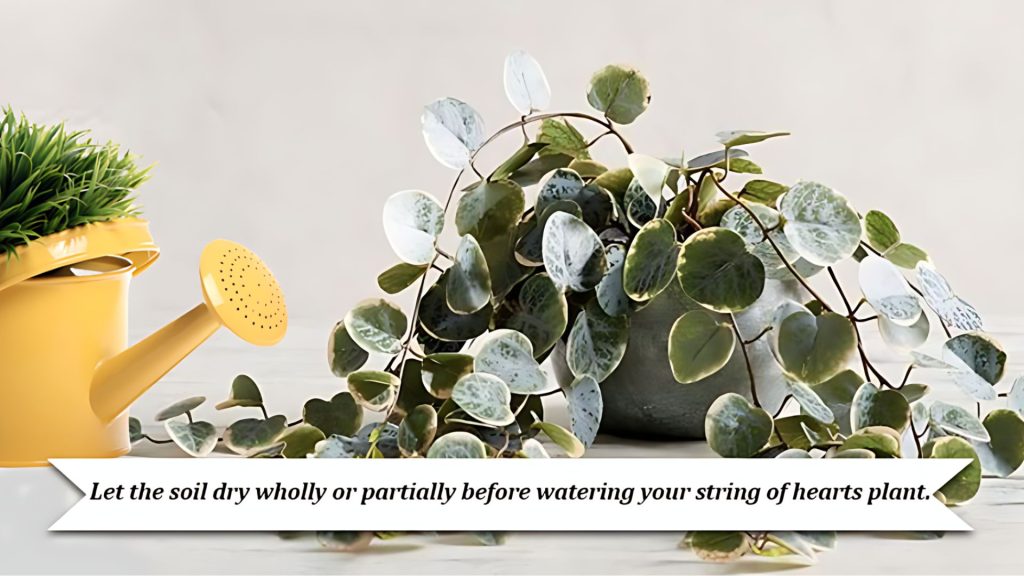
Proper watering and feeding are crucial for maintaining a healthy String of Hearts plant.
This section will guide you through the correct watering techniques and fertilization schedule to ensure your plant thrives year-round.
Watering Schedule
A string of Hearts plants are succulent-like and prefer to dry out between waterings.
The key is to water thoroughly but infrequently.
A good rule of thumb is to check the soil moisture level by inserting your finger into the soil.
When the soil feels dry about 2/3 of the way down the pot, it’s time to water.
When watering, thoroughly saturate the soil until water runs out of the drainage holes.
This ensures that water reaches all parts of the root system.
After watering, always empty the saucer to prevent the plant from sitting in standing water.
During the winter months, reduce watering frequency to prevent root rot.
The plant enters a period of dormancy and requires less water.
Allow the soil to dry out completely between waterings during this time.
An effective technique for watering String of Hearts is bottom watering.
Place the pot in a water tray for 10-15 minutes, allowing the soil to absorb water from the bottom up.
This method promotes even moisture distribution and encourages deeper root growth.
Fertilization
Fertilizing your String of Hearts helps replenish essential nutrients in the soil, promoting healthy growth and vibrant foliage.
Use a balanced, water-soluble fertilizer specifically formulated for succulents or houseplants.
During the growing season (spring and summer), fertilize your String of Hearts once a month.
Dilute the fertilizer to half the recommended strength to avoid over-fertilization, which can damage the plant.
It’s important to avoid fertilizing during the plant’s dormant period in fall and winter.
The plant’s growth slows down during this time, and it doesn’t require additional nutrients.
Fertilizing during dormancy can lead to salt buildup in the soil and potentially harm the plant.
When you resume fertilizing in spring, start with a weak solution and gradually increase to the recommended dilution over a few applications.
This helps the plant adjust and prevents fertilizer burn.
4. Routine Care
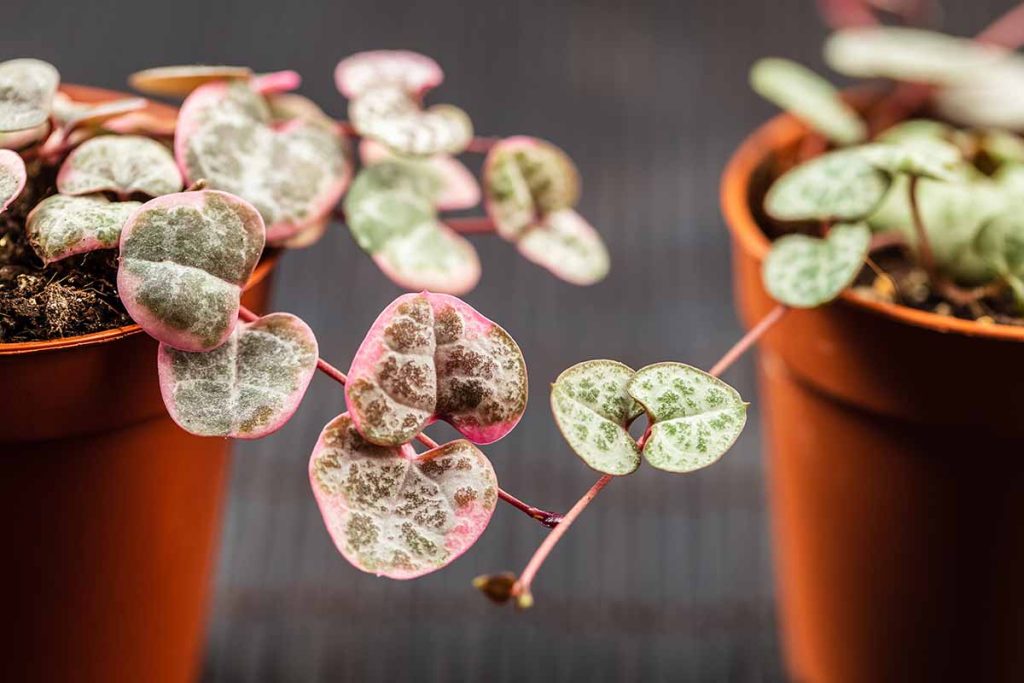
Regular care and maintenance are essential for keeping your String of Hearts plant healthy and attractive.
This section covers important routine tasks to help your plant thrive and maintain its beautiful appearance.
Pruning and Maintenance
Pruning is an important aspect of String of Hearts care that helps control the plant’s length and promotes bushier growth.
Regular pruning keeps your plant looking neat and encourages new growth, resulting in a fuller, more lush appearance.
To prune your String of Hearts, identify any leggy or overgrown stems.
These are typically long strands with sparse leaves or areas where the plant looks thin.
Cut these stems just below a leaf node (the point where leaves emerge from the stem) using clean, sharp scissors or pruning shears.
This encourages new growth to sprout from that point.
Don’t be afraid to be somewhat aggressive with your pruning – String of Hearts plants can handle it well.
You can cut back up to one-third of the plant’s length without causing harm.
Always use sharp tools to make clean cuts and prevent damage or disease.
Remember to sanitize your pruning tools before and after use to prevent the spreading of any potential diseases between plants.
You can do this by wiping the blades with rubbing alcohol or diluting bleach.
Dusting and Rotating
Regular dusting of your String of Hearts’ leaves is an often overlooked but important part of plant care.
Dust can accumulate on the leaves over time, blocking sunlight and reducing the plant’s ability to photosynthesize effectively.
This can lead to slower growth and less vibrant foliage.
To dust your plant, gently wipe the leaves with a soft, damp cloth or brush.
Be careful not to damage the delicate leaves or stems while cleaning.
For hard-to-reach areas, you can use a can of compressed air, holding it at a distance to avoid damaging the plant.
Rotating your String of Hearts plant regularly is another simple yet effective care technique.
Turning the pot a quarter turn every week or two ensures that all sides of the plant receive equal light exposure.
This promotes even growth and prevents the plant from becoming crooked or growing towards the light source.
Consistent rotation also allows you to inspect all sides of the plant regularly, making it easier to spot any potential issues like pests or diseases early on.
This proactive approach to plant care can help you address problems before they become serious, keeping your String of Hearts healthy and thriving.
5. Propagation Techniques

Propagating your String of Hearts is a rewarding way to expand your plant collection or share this beautiful succulent with friends.
There are several effective methods to propagate these plants, each with advantages.
Let’s explore three popular techniques to create new String of Hearts plants.
Water Propagation
Water propagation is a popular method for String of Hearts due to its simplicity and high success rate.
To begin, select a healthy stem and cut it just below a leaf node, ensuring your cutting is about 4-6 inches long.
Remove the leaves from the bottom inch of the stem.
Place the cutting in a clear glass or jar filled with room temperature water, making sure the leaf nodes are submerged.
Change the water every few days to keep it fresh and prevent bacterial growth.
Within a few weeks, you should see small roots beginning to form.
Once the roots are about an inch long, carefully transfer the cutting to a pot with well-draining soil.
Keep the soil slightly moist for the first few weeks to help the plant adjust to its new environment.
Gradually reduce watering as the plant establishes itself in the soil.
Soil Propagation
Soil propagation is another effective method for String of Hearts.
Start by preparing a small pot with a well-draining succulent soil mix.
Take a healthy cutting as described in the water propagation method, but instead of placing it in water, dip the cut end in the rooting hormone (optional but can improve success rates).
With a pencil or similar object, create a small hole in the soil and gently insert the cutting, ensuring that at least one node is buried.
Lightly press the soil around the stem to secure it in place.
Keep the soil moist but not waterlogged, and place the pot in a warm, bright location out of direct sunlight.
After a few weeks, gently tug on the cutting.
If you feel resistance, it means roots have developed.
At this point, you can begin treating it like a mature String of Hearts plant.
Tuber Propagation
String of Hearts plants often develop small, bead-like tubers along their stems.
These tubers can be used to propagate new plants.
To use this method, locate a tuber on your plant – they’re usually about the size of a pea and have a pinkish-brown color.
Press the tuber into moist, well-draining soil, exposing the top half.
Keep the soil lightly moist and place the pot in a warm, bright location.
Over time, the tuber will develop roots and eventually sprout new growth.
This method can take longer than stem cuttings, but it’s a great way to use the plant’s natural growth to create new plants.
You can also leave the tuber attached to the mother plant while it develops roots, only separating it once new growth has appeared.
6. Troubleshooting Common Problems

Hearts plants can sometimes encounter issues even with the best care.
Identifying and addressing common problems will help you keep your plant healthy and thriving.
This section covers the most frequent issues and how to resolve them.
Light Issues
Proper lighting is crucial for the health of your String of Hearts.
Both too little and too much light can cause problems for your plant.
Insufficient light often results in large spaces between leaves, a condition known as etiolation.
If you notice your plant becoming leggy with sparse foliage, it’s likely not receiving enough light.
Move your plant to a brighter location, but be careful to introduce it to more light gradually to prevent shock.
On the other hand, too much direct sunlight can lead to scorched or crispy leaves.
If you see brown spots or edges on the leaves, your plant may get too much intense light.
In this case, move it to a spot with bright but indirect light or use a sheer curtain to filter strong sunlight.
Watering Issues
Both overwatering and underwatering can cause problems for your String of Hearts.
Overwatering is a common issue that can lead to yellowing leaves and, in severe cases, root rot.
If you notice your plant’s leaves turning yellow or feeling mushy, and the soil stays consistently damp, you’re likely overwatering.
Reduce your watering frequency and ensure your pot has good drainage.
In cases of suspected root rot, you may need to repot the plant in fresh, dry soil after trimming away any rotted roots.
While less common, underwatering can also be problematic.
Signs of underwatering include wilted or deflated leaves that feel soft and pliable.
If you notice these symptoms, give your plant a good soak, allowing water to run through the drainage holes.
Then, adjust your watering schedule to prevent the soil from drying out completely.
Pest Control
While String of Hearts plants are generally resistant to pests, they can occasionally fall victim to common houseplant insects.
Mealybugs are small, white, cotton-like insects that cluster on stems and leaf joints.
Though tiny and hard to see, Spider mites can be identified by the fine webbing they leave on the plant.
These pests feed on plant sap, weakening your String of Hearts over time.
To treat these pests, isolate the affected plant to prevent spread.
Then, use a cotton swab dipped in rubbing alcohol to remove visible pests.
For larger infestations, spray the plant with an organic pesticide like neem oil.
Treat the plant weekly for at least a month to break the pest life cycle.
Preventative measures, such as regularly inspecting your plants and maintaining good air circulation, can help keep pest problems at bay.
Early detection and prompt treatment are key to managing pest issues effectively.
7. Seasonal Care
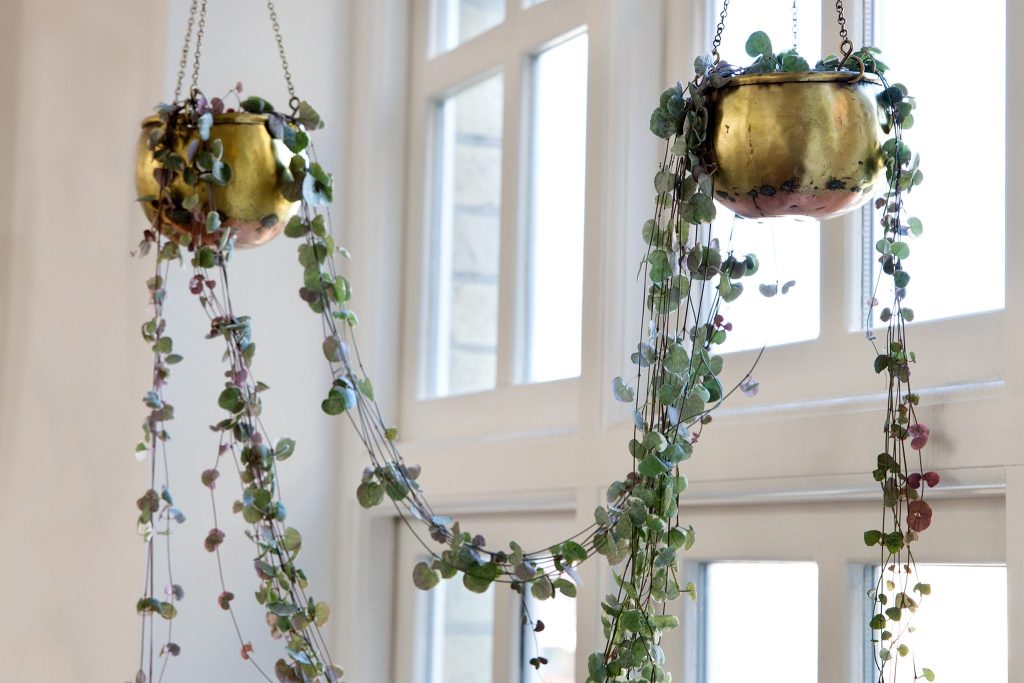
Understanding how to care for your String of Hearts throughout the year is crucial for maintaining its health and promoting optimal growth.
This plant has different needs as the seasons change, particularly during its dormancy period in winter and when grown outdoors in warmer climates.
Dormancy in Winter
String of Hearts plants enter a period of dormancy during the colder months, typically from late fall through winter.
Their growth slows significantly during this time, and their care needs change accordingly.
As winter approaches, gradually reduce watering frequency.
The soil should be allowed to dry out almost completely between waterings, as the plant requires much less moisture during dormancy.
A good rule of thumb is to water about half as often as you do during the growing season.
Be careful not to overwater during this time, as excess moisture can lead to root rot when the plant isn’t actively growing.
Light exposure should also be adjusted during dormancy.
While String of Hearts still appreciates bright light, it can tolerate slightly lower light levels during this period.
If your plant is near a window that gets cold in winter, consider moving it slightly further away to protect it from chilly drafts.
As spring approaches and days lengthen, gradually reintroduce more frequent watering and brighter light.
This slow transition helps the plant ease out of dormancy without shock.
You may notice new growth appearing – this is a sign that your plant is ready to enter its active growing phase again.
Outdoor Growth
String of Hearts can be grown outdoors year-round in USDA hardiness zones ten and above, where temperatures consistently stay above 60°F (15°C).
In these warm climates, the plant can be used as a beautiful trailing addition to hanging baskets or as ground cover in rock gardens.
When growing String of Hearts outdoors, protection from extreme conditions is key.
While these plants love bright light, they should be shielded from intense, direct sunlight during the hottest day to prevent leaf scorch.
A spot that receives morning sun and afternoon shade is ideal.
Be vigilant about temperature drops in outdoor settings, especially in the transitional seasons.
If temperatures are forecast to fall below 60°F (15°C), moving your plant indoors or providing protection is best.
A cold frame or horticultural fleece can temporarily protect during brief cold spells.
Outdoor plants may also need more frequent watering than their indoor counterparts, especially during hot, dry periods.
However, always check the soil moisture before watering to avoid overwatering.
Adjusting your care routine to accommodate these seasonal changes will ensure that your String of Hearts remains healthy and vibrant throughout the year, whether it’s spending time indoors or out in the garden.
8. Enhancing Plant Health
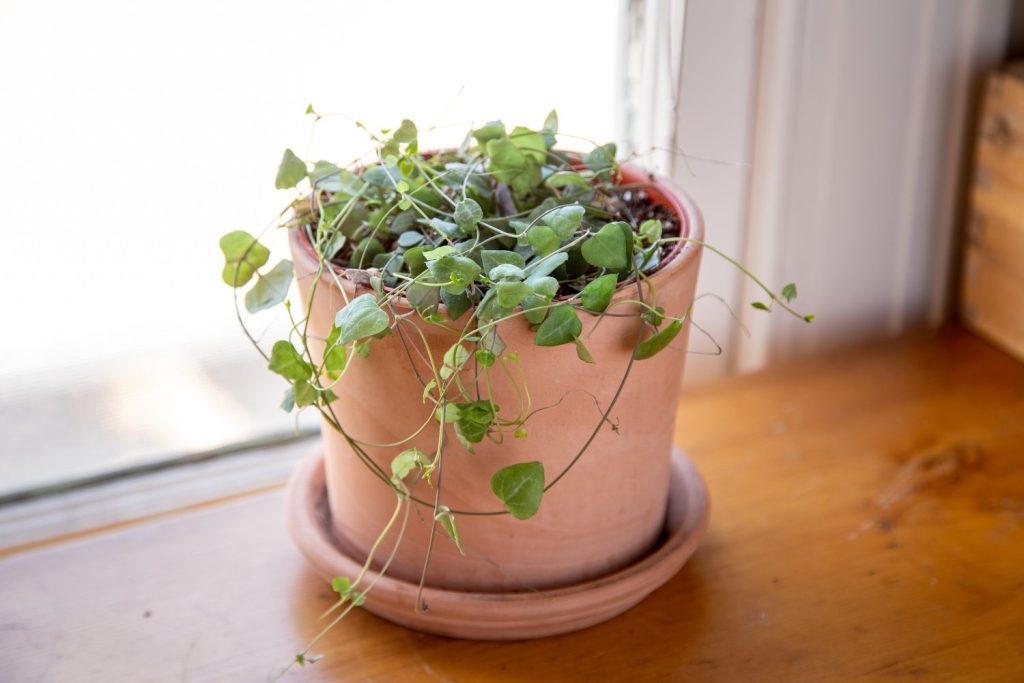
Ensuring your String of Hearts reaches its full potential involves more than basic care.
Implementing specific techniques can enhance your plant’s health, encourage fuller growth, and promote flowering.
This section will guide you through methods to make your String of Hearts thrive and become a stunning focal point in your plant collection.
Making String of Hearts Fuller
One of the most common desires among String of Hearts owners is to achieve a fuller, bushier plant.
While naturally a trailing plant, there are several techniques you can use to encourage denser growth.
Regular pruning is key to promoting fullness.
Pruning your String of Hearts encourages the plant to branch out, creating a more lush appearance.
Cut just above a leaf node, and the plant will often sprout two new stems from that point.
Don’t be afraid to prune regularly—it benefits the plant’s overall health and appearance.
Another effective technique is to take your pruned cuttings and replant them back into the same pot.
This method, sometimes called “the butterfly method,” involves taking shortcuttings with a couple of leaves, removing the lower leaf, and planting the stem directly into the soil of the parent plant.
This creates new growth points and fills out the top of the plant.
Consider periodically “layering” long vines back into the pot to maintain a fuller appearance.
Create a small loop with a section of the vine and pin it down to the soil surface.
It will eventually root, creating a new growth point and adding to the plant’s fullness.
Flowering Encouragement
While String of Hearts is primarily grown for its attractive foliage, it can produce small, tubular flowers that add another dimension of beauty to the plant.
To encourage flowering, focus on providing optimal care and creating the right conditions.
First and foremost, ensure your plant is receiving adequate light.
String of Hearts needs bright, indirect light to produce flowers.
A location near a south or west-facing window often provides the ideal light conditions for flowering.
Proper watering and fertilization are also crucial for flower production.
During the growing season (spring and summer), ensure your plant receives enough water without being overwatered.
Allow the soil to dry out between waterings, but don’t let the plant stay dry for extended periods.
Fertilizing during the growing season can significantly promote flowering.
Use a balanced, water-soluble fertilizer formulated for succulents or flowering plants.
Apply the fertilizer at half-strength once a month during spring and summer.
Be careful not to over-fertilize, as this can lead to excessive foliage growth at the expense of flowers.
Lastly, be patient.
String of Hearts typically flowers in late summer or early fall, and young or recently propagated plants may take a year or two before they start producing flowers.
By providing consistent, optimal care, you’re setting the stage for your plant to bloom when ready.
Remember, while flowers are a beautiful bonus, String of Hearts’ primary appeal lies in its unique foliage.
Even if your plant doesn’t flower, with proper care and these enhancement techniques, you can still enjoy a healthy, lush, and visually striking plant.
Conclusion
The String of Hearts is a captivating and relatively low-maintenance plant that can thrive in most indoor environments with proper care.
By providing the right balance of light, water, and nutrients, you can help your plant flourish and become a stunning addition to your home.
Remember to adjust your care routine seasonally, especially during the winter dormancy.
Don’t be afraid to prune and propagate your plant to encourage fuller growth and expand your collection.
While challenges may arise, most common issues can be easily addressed with prompt attention and care.
Whether growing your String of Hearts indoors or in a suitable outdoor climate, this versatile plant offers beauty and interest year-round.
With the knowledge gained from this guide, you’re well-equipped to nurture a healthy, vibrant String of Hearts that will bring joy for years to come.





